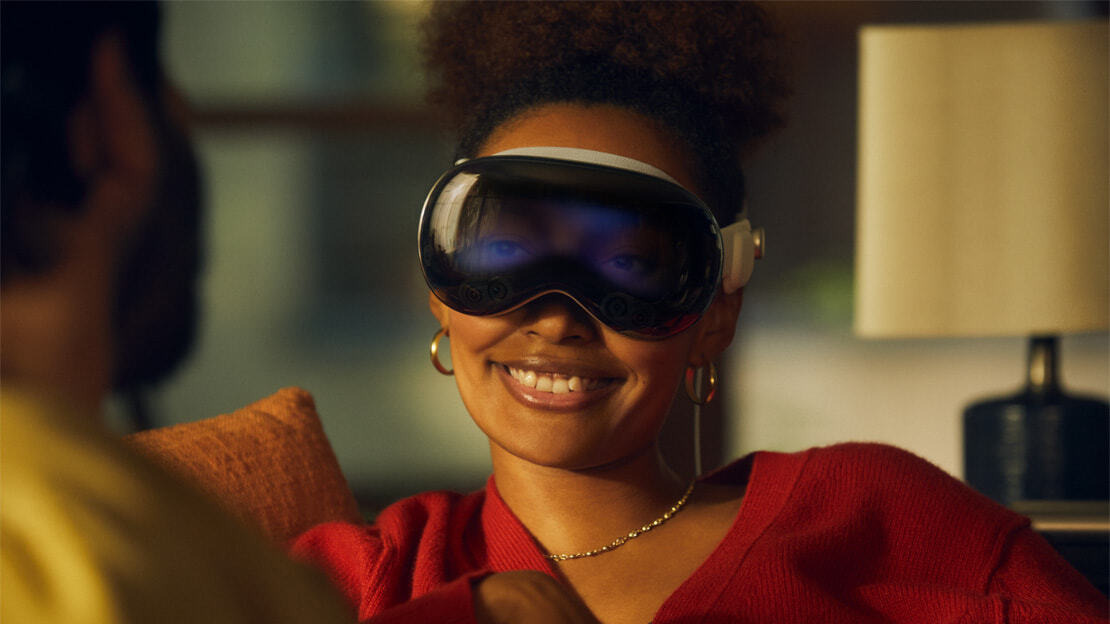
Initially suspicious of virtual reality and desiring less device time, not more, Adventure.com’s Kassondra Cloos finds a lot to love about ‘traveling’ on the new Apple Vision Pro headset.


Initially suspicious of virtual reality and desiring less device time, not more, Adventure.com’s Kassondra Cloos finds a lot to love about ‘traveling’ on the new Apple Vision Pro headset.
When I say that the Apple Vision Pro has some redeeming qualities—and is even, perhaps, very cool—I am doing so with reservation.
I’ve spent the last year reviewing products to reduce my screentime; I don’t want to live in a world where we all sit on our couches and hang out together in the metaverse in spirit. I want to go places and do things and see people, for real.
At the same time, I also want a Vision Pro.
If you’re unfamiliar with Apple’s foray into the VR world, this USD$3,500 device allows you to work, communicate, and ‘travel’ within remarkably realistic environments. During the course of drafting this piece, for example, I ‘went’ to White Sands National Park in New Mexico and worked on a virtual laptop display hovering beneath a brilliant sunset. Then I went to Bora Bora, where I watched turquoise waves wash up on the shore.
Now? I’m on the moon.
The Milky Way is quite distracting, actually. I need to be looking at this Word document, but all I want to do is stare at the night sky. I know it’s not real, of course, but it’s shockingly convincing. It’s a static image with the depth of reality. I keep looking up from my work to stare at the Earth.
Apple loaned me the device to try out for this review, which I’ve been using for a little over two months. Initially, I was most excited about the ability to work from within focused environments, so I could swap the blank wall behind my desk for seemingly endless desert, mountain, and moon views.
Far more exciting, however, are the short, immersive films Apple TV has produced for the Vision. It’s not like watching a 3D film in a movie theater; it’s like actually being there.Only it’s better, because you’re not on the sidelines—you’re right in the heart of the action.
In the last few weeks, I’ve been inches away from slackliner Faith Dickey as she traversed a highline 3,000 feet above Norwegian fjords. I’ve held my breath as freediver Ant Williams swam for a world record below thick Icelandic ice, I’ve floated over Cappadocia, Turkey, in a hot air balloon, and I came nose-to-nose with sharks in the Bahamas.
During a short film about bull riding at a Utah rodeo, I was so transported that I flinched and burrowed deeper into my couch when the bulls charged the camera. I have been to a rodeo in real life, and it was not nearly as exhilarating. There’s a huge difference between being ‘in’ something and seeing it from a distance, as a friend told me when I showed her the rodeo film, Man vs. Beast, and then sent her to the moon.
This is why I have some mixed feelings about the Vision. It has triggered that ‘what if’ spiral that’s suspicious of new tech like ChatGPT and self-driving cars. Maybe with such convincing imagery, people will want to spend more time behind goggles than out there, in the real world, experiencing nature for themselves. That part of me wants us all to go back to film cameras and landline phones.
At the same time, the Vision Pro is a powerful tool with potential to be a force for good. The Explore POV app, for example, offers dozens of landscape videos that take you on hikes through jungles, rain forests, and dramatic mountain vistas. Nature ‘immersion’ via VR can help people de-stress, and I imagine it could also offer mental health benefits for people with mobility issues who otherwise could not travel there themselves.
As much as I like reality better than looking at screens, I do like the idea of a future where I can ‘go’ to the most touristy places on Earth without braving the crowds myself.
The Vision Pro also does 2D content extremely well. When I watch a movie on Netflix on my computer, I’m easily distracted. The Vision Pro, however, is like turning your house into an IMAX theater. When you enter ‘cinema’ mode on Apple TV, Disney Plus, and IMAX, all you can see is the movie and the empty ‘theater’ around you. You couldn’t use your phone even if you wanted to, because you wouldn’t be able to see it. Watching bits of the Pandas movie in 3D was a joyful experience.
We’re still in the early days of this technology, and it’s far from accessible to the average household. If it gets more affordable, however, I think we’ll all be done with scrolling through travel TikToks and Reels forever. Instead, filmmakers will bring us along for the ride. We’ll get to engage more deeply with places that are expensive, challenging, or dangerous to get to. Sometimes, this might satisfy us, and sometimes, it might inspire us to go there ourselves.
As much as I like reality better than looking at screens, I do like the idea of a future where I can ‘go’ to the most touristy places on Earth without braving the crowds myself.
I’d like to see the Venetian canals, for example, but I’d much rather spend my time and money on wilderness treks and adventure trips. I’d also love to see Antarctica and the reefs of Australia without all the environmentally-taxing travel. I’d be shocked if we don’t have an immersive Vision Pro experience on Everest within the next few years (whether we should is another story entirely).
The Vision Pro also offers an engaging new way to engage with your own travel photos and videos. The device can take ‘spatial’ photos and videos with great depth of field, so that it looks like you’re viewing something in real life. The iPhone 16 also has this capability and is much easier to use for footage while traveling. When you view them in the ‘immersive’ mode on the Vision Pro, however, the depth of field is such that you can feel transported back to the moment you shot.
In December, I visited Block Island, off the coast of Rhode Island, and spent an hour watching seals play in the shallow waters. When I watch the spatial videos I shot on my iPhone on the Vision Pro, I feel almost like I’m there watching it again. It’s not as immersive as the moon, but it looks like I’m gazing out a window watching it all unfold in real life again. It’s a pretty cool way to relive fun travel memories.
There are some practical drawbacks to the device that are worth mentioning. When you see someone wearing the device, you might think you’re seeing their eyes. But what you’re actually seeing is an external screen with a realistic approximation of the user’s face.
While you can see your home and people around you while you’re using the device, you can’t actually see through it. What you’re really seeing behind the apps and windows in the Vision Pro is a real-time movie of the world around you. At night, or in poor lighting, your surroundings can look quite fuzzy. I found it disconcerting at times that the virtual content was always sharper than reality.
The device is heavy, and not entirely wireless. It needs to be attached to its battery pack—about the size of two iPhones stacked on top of one another—at all times, which only lasts for about two hours. It’s also bulky. When the goggles are tucked into their padded, zippered travel case, it takes up most of the space you’re allotted for a personal item on an airplane. (I must admit that I have not tried wearing them on a plane, which I imagine could be fantastic, because I was worried about looking ridiculous).
If price were no issue (and if you could promise me that we won’t soon suffer the fate of the humans in WALL-E who live in hovering armchairs with VR projections), I’d say everyone should have one. As a tool, a toy, and a home theater, the Vision Pro is super cool and has amazing potential.
But if you have to choose between the Vision Pro and taking a trip, I say go travel. Take the trip now, and go for the Vision Pro in a future iteration, when it will have more content, more apps, more ‘experiences’, and, hopefully, will cost a little less.
A note on sustainable consumerism: Adventure.com acknowledges that electronics and web content consumption have an environmental impact. We prioritize sustainable options as much as possible. In all cases, we strive to provide thorough, honest reviews to help inform your decision-making and be a more intentional consumer.
***
Adventure.com strives to be a low-emissions travel publication. We are powered by, but editorially independent of, Intrepid Travel, the world’s largest travel B Corp, who help ensure Adventure.com maintains high standards of sustainability in our work and activities. You can visit our sustainability page or read our Contributor Impact Guidelines for more information.

Kassondra Cloos is a travel journalist from Rhode Island living in London, and Adventure.com's news and gear writer. Her work focuses on slow travel, urban outdoor spaces and human-powered adventure. She has written about kayaking across Scotland, dog sledding in Sweden and road tripping around Mexico. Her latest work appears in The Guardian, Backpacker and Outside, and she is currently section-hiking the 2,795-mile England Coast Path.








Can't find what you're looking for? Try using these tags: